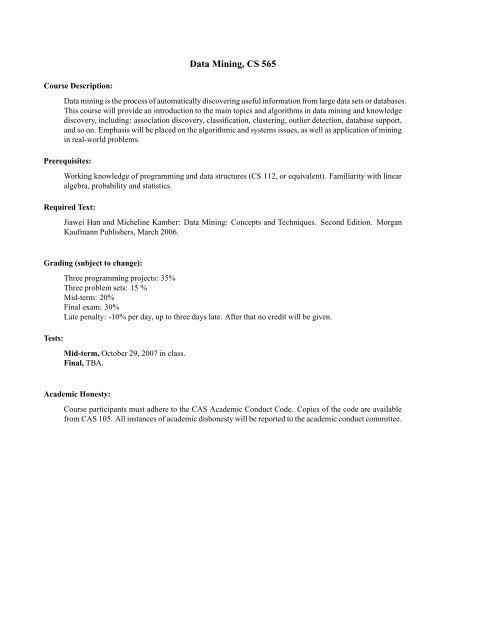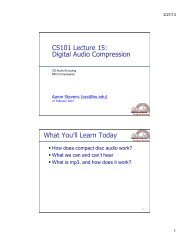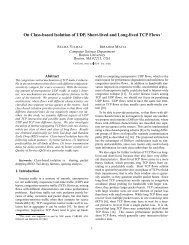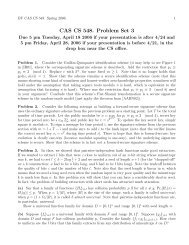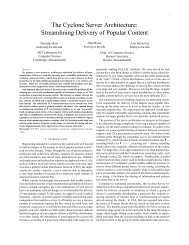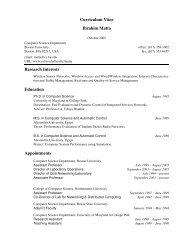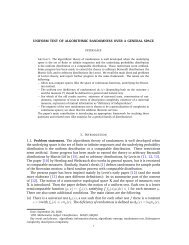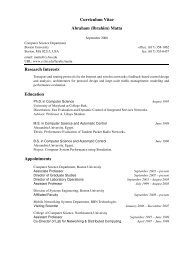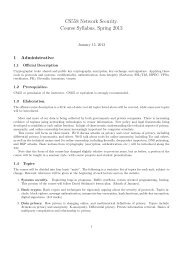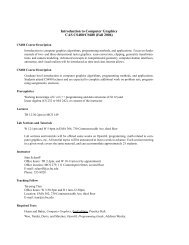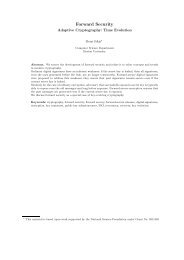Data Mining, CS 565
Data Mining, CS 565
Data Mining, CS 565
You also want an ePaper? Increase the reach of your titles
YUMPU automatically turns print PDFs into web optimized ePapers that Google loves.
<strong>Data</strong> <strong>Mining</strong>, <strong>CS</strong> <strong>565</strong><br />
Course Description:<br />
<strong>Data</strong> mining is the process of automatically discovering useful information from large data sets or databases.<br />
This course will provide an introduction to the main topics and algorithms in data mining and knowledge<br />
discovery, including: association discovery, classification, clustering, outlier detection, database support,<br />
and so on. Emphasis will be placed on the algorithmic and systems issues, as well as application of mining<br />
in real-world problems.<br />
Prerequisites:<br />
Working knowledge of programming and data structures (<strong>CS</strong> 112, or equivalent). Familiarity with linear<br />
algebra, probability and statistics.<br />
Required Text:<br />
Jiawei Han and Micheline Kamber: <strong>Data</strong> <strong>Mining</strong>: Concepts and Techniques. Second Edition. Morgan<br />
Kaufmann Publishers, March 2006.<br />
Grading (subject to change):<br />
Tests:<br />
Three programming projects: 35%<br />
Three problem sets: 15 %<br />
Mid-term: 20%<br />
Final exam: 30%<br />
Late penalty: -10% per day, up to three days late. After that no credit will be given.<br />
Mid-term, October 29, 2007 in class.<br />
Final, TBA.<br />
Academic Honesty:<br />
Course participants must adhere to the CAS Academic Conduct Code. Copies of the code are available<br />
from CAS 105. All instances of academic dishonesty will be reported to the academic conduct committee.
Schedule (subject to change):<br />
Date Topic Assignments Out<br />
Sep<br />
5 Introduction<br />
10 <strong>Data</strong> Warehousing: Basic Concepts<br />
12 <strong>Data</strong> Warehousing: Design and Implementation<br />
17 OLAP Evaluation Techniques Problem Set 1<br />
19 <strong>Data</strong> Preprocessing and <strong>Data</strong> Cleaning<br />
24 <strong>Mining</strong> Association Rules Algorithms: Definitions and Apriori Algorithm<br />
26 Algorithms for Frequent Itemset <strong>Mining</strong>: FP-Tree, MaxMiner<br />
Oct<br />
1 Closed and Maximal Itemset <strong>Mining</strong> : MAFIA, CLOSET Program 1: Association Rules <strong>Mining</strong><br />
3 Association <strong>Mining</strong> and Correlation Analysis<br />
9 Scalable Classification Algorithms: SPRINT and SLIQ<br />
10 Scalable Classification Algorithms: RainForest Framework<br />
15 Clustering Large <strong>Data</strong>sets: CLARANS and BIRCH Problem Set 2<br />
17 Clustering Large <strong>Data</strong>sets: CURE and DBSCAN<br />
22 Clustering Large <strong>Data</strong>sets: CHAMELEON and Graph based Clustering<br />
24 Projective and Subspace Clustering: CLIQUE and DOC<br />
29 Mid-Term<br />
31 Time Series Clustering and Classification Program 2: Clustering<br />
Nov<br />
5 <strong>Data</strong> Streams <strong>Mining</strong><br />
7 Sequential Pattern <strong>Mining</strong>: SPADE, SPAM<br />
14 Sequential Pattern <strong>Mining</strong>: <strong>Mining</strong> Periodic Patterns<br />
19 Sequential Pattern <strong>Mining</strong> with Constraints<br />
21 Graph <strong>Mining</strong> Program 3: Sequential <strong>Mining</strong><br />
26 Privacy Preserving <strong>Data</strong> <strong>Mining</strong><br />
28 Privacy Preserving <strong>Data</strong> <strong>Mining</strong> (cont.)<br />
Dec<br />
3 Outlier Detection: Basic Concepts and Definitions<br />
5 Outlier Detection Algorithms Problem Set 3<br />
10 Spatial <strong>Data</strong> <strong>Mining</strong><br />
12 Spatio-temporal <strong>Data</strong> <strong>Mining</strong>


